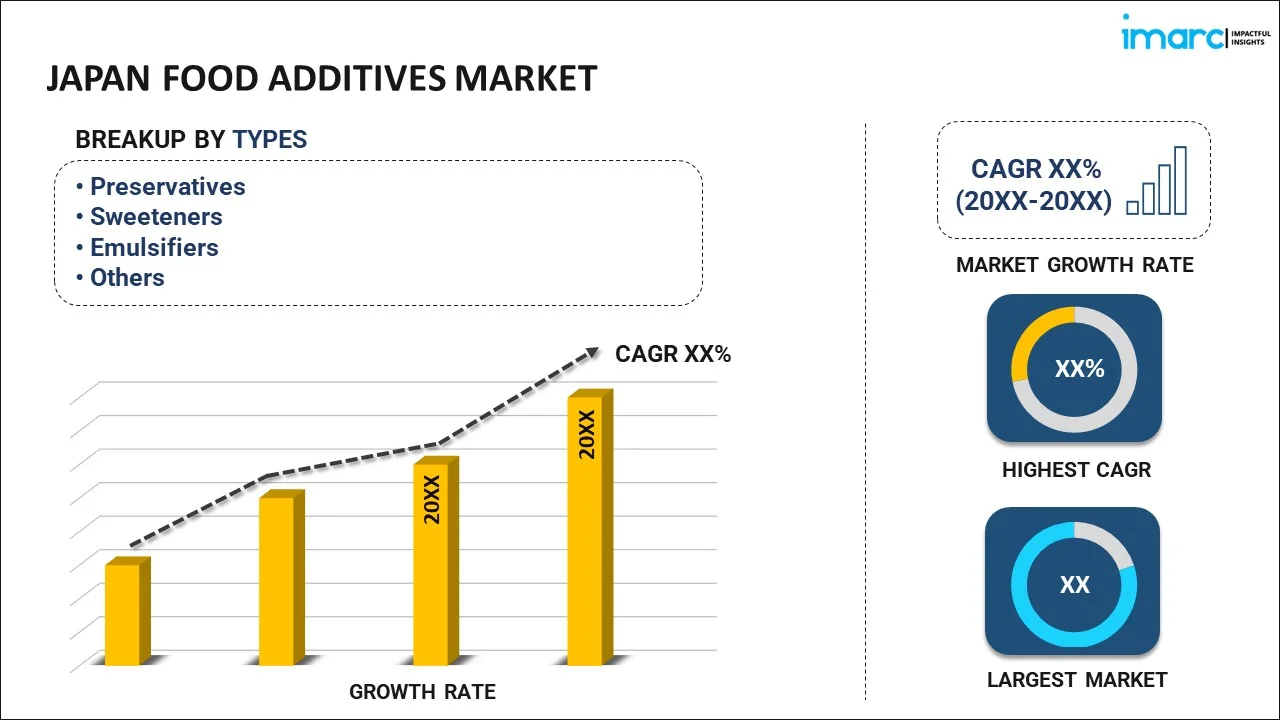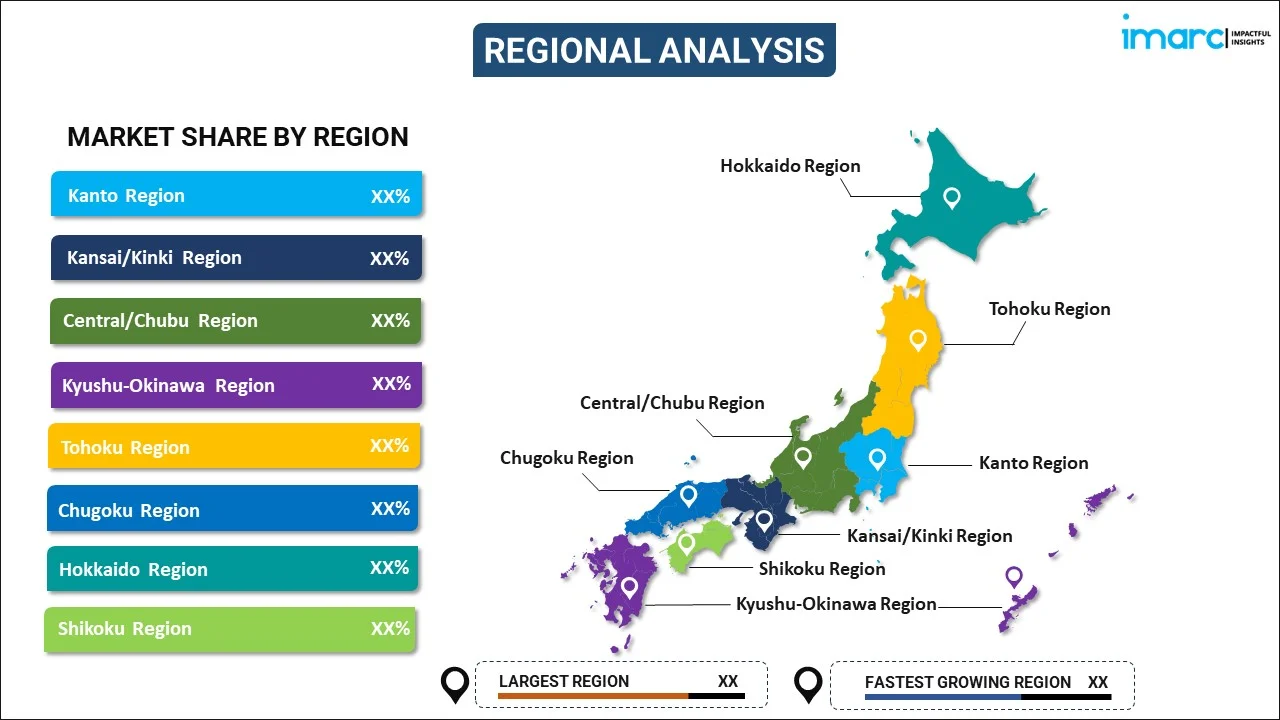
Japan Food Additives Market Report by Type (Preservatives, Sweeteners, Emulsifiers, Food Flavors and Colorants, and Others), Application (Beverages, Bakery, Meat and Meat Products, Dairy Products, and Others), and Region 2025-2033
Market Overview:
Japan food additives market size reached USD 3,702.0 Million in 2024. Looking forward, IMARC Group expects the market to reach USD 5,001.0 Million by 2033, exhibiting a growth rate (CAGR) of 3.4% during 2025-2033. The increasing advancement in technologies, such as automation, robotics, and data analytics, that have streamlined the manufacturing processes for food additives, making them more accessible and affordable, are primarily driving the market.
|
Report Attribute
|
Key Statistics
|
|---|---|
|
Base Year
|
2024 |
|
Forecast Years
|
2025-2033
|
|
Historical Years
|
2019-2024
|
| Market Size in 2024 | USD 3,702.0 Million |
| Market Forecast in 2033 | USD 5,001.0 Million |
| Market Growth Rate (2025-2033) | 3.4% |
Food additives are substances introduced to food to enrich flavor, appearance, and texture or to prolong shelf life. They encompass preservatives, sweeteners, emulsifiers, stabilizers, colorings, and flavorings, serving multiple purposes. They are critical for enhancing the longevity of products, intensifying flavors, refining texture, imparting colors, moderating acidity levels, consolidating emulsions, and maintaining moisture. They are essential in averting spoilage, improving taste, heightening visual allure, augmenting palatability, fortifying nutritional value, and ensuring consistency in food. They present several benefits, including being economical, providing consistent quality, simplifying preparation processes, minimizing waste, and elevating food safety. These additives play a pivotal role in the food industry, offering myriad solutions for both producers and consumers, addressing various needs and preferences in food consumption and production. They are integral in delivering diverse, safe, and high-quality food products, meeting the evolving demands and preferences of consumers while also addressing concerns related to food preservation and waste reduction.
Japan Food Additives Market Trends:
The food additives market in Japan is poised for substantial growth due to a confluence of market drivers. Firstly, increasing consumer demand for convenience foods and processed products has been a significant catalyst. These items often rely on additives for shelf-life extension and flavor enhancement, thus driving the market's expansion. Moreover, stringent regulations governing food safety have prompted manufacturers to seek innovative additives that can meet regulatory standards. This has fueled R&D activities in the industry, propelling market growth. In addition to this, the regional population's growing health consciousness has led to a surge in demand for natural and organic additives. As a result, companies are increasingly investing in the production and marketing of clean-label additives, contributing to market expansion. Furthermore, urbanization in Japan has led to changing dietary patterns and preferences, favoring the food additives market. Lastly, technological advancements and the adoption of novel food processing techniques, which help in increasing efficiency, reducing production costs, and enhancing quality control, are expected to drive the market in Japan during the forecast period.
Japan Food Additives Market Segmentation:
IMARC Group provides an analysis of the key trends in each segment of the market, along with forecasts at the country level for 2025-2033. Our report has categorized the market based on type and application.
Type Insights:

- Preservatives
- Sweeteners
- Emulsifiers
- Food Flavors and Colorants
- Others
The report has provided a detailed breakup and analysis of the market based on the type. This includes preservatives, sweeteners, emulsifiers, food flavors and colorants, and others.
Application Insights:
- Beverages
- Bakery
- Meat and Meat Products
- Dairy Products
- Others
A detailed breakup and analysis of the market based on the application have also been provided in the report. This includes beverages, bakery, meat and meat products, dairy products, and others.
Regional Insights:

- Kanto Region
- Kansai/Kinki Region
- Central/ Chubu Region
- Kyushu-Okinawa Region
- Tohoku Region
- Chugoku Region
- Hokkaido Region
- Shikoku Region
The report has also provided a comprehensive analysis of all the major regional markets, which include Kanto Region, Kansai/Kinki Region, Central/ Chubu Region, Kyushu-Okinawa Region, Tohoku Region, Chugoku Region, Hokkaido Region, and Shikoku Region.
Competitive Landscape:
The market research report has also provided a comprehensive analysis of the competitive landscape. Competitive analysis such as market structure, key player positioning, top winning strategies, competitive dashboard, and company evaluation quadrant has been covered in the report. Also, detailed profiles of all major companies have been provided.
Japan Food Additives Market Report Coverage:
| Report Features | Details |
|---|---|
| Base Year of the Analysis | 2024 |
| Historical Period | 2019-2024 |
| Forecast Period | 2025-2033 |
| Units | Million USD |
| Scope of the Report | Exploration of Historical Trends and Market Outlook, Industry Catalysts and Challenges, Segment-Wise Historical and Future Market Assessment:
|
| Types Covered | Preservatives, Sweeteners, Emulsifiers, Food Flavors and Colorants, Others |
| Applications Covered | Beverages, Bakery, Meat and Meat Products, Dairy Products, Others |
| Regions Covered | Kanto Region, Kansai/Kinki Region, Central/ Chubu Region, Kyushu-Okinawa Region, Tohoku Region, Chugoku Region, Hokkaido Region, Shikoku Region |
| Customization Scope | 10% Free Customization |
| Post-Sale Analyst Support | 9-11 Weeks |
| Delivery Format | PDF and Excel through Email (We can also provide the editable version of the report in PPT/Word format on special request) |
Key Questions Answered in This Report:
- How has the Japan food additives market performed so far and how will it perform in the coming years?
- What has been the impact of COVID-19 on the Japan food additives market?
- What is the breakup of the Japan food additives market on the basis of type?
- What is the breakup of the Japan food additives market on the basis of application?
- What are the various stages in the value chain of the Japan food additives market?
- What are the key driving factors and challenges in the Japan food additives?
- What is the structure of the Japan food additives market and who are the key players?
- What is the degree of competition in the Japan food additives market?
Key Benefits for Stakeholders:
- IMARC’s industry report offers a comprehensive quantitative analysis of various market segments, historical and current market trends, market forecasts, and dynamics of the Japan food additives market from 2019-2033.
- The research report provides the latest information on the market drivers, challenges, and opportunities in the Japan food additives market.
- Porter's five forces analysis assist stakeholders in assessing the impact of new entrants, competitive rivalry, supplier power, buyer power, and the threat of substitution. It helps stakeholders to analyze the level of competition within the Japan food additives industry and its attractiveness.
- Competitive landscape allows stakeholders to understand their competitive environment and provides an insight into the current positions of key players in the market.
Need more help?
- Speak to our experienced analysts for insights on the current market scenarios.
- Include additional segments and countries to customize the report as per your requirement.
- Gain an unparalleled competitive advantage in your domain by understanding how to utilize the report and positively impacting your operations and revenue.
- For further assistance, please connect with our analysts.
 Inquire Before Buying
Inquire Before Buying
 Speak to an Analyst
Speak to an Analyst
 Request Brochure
Request Brochure
 Request Customization
Request Customization




.webp)




.webp)












